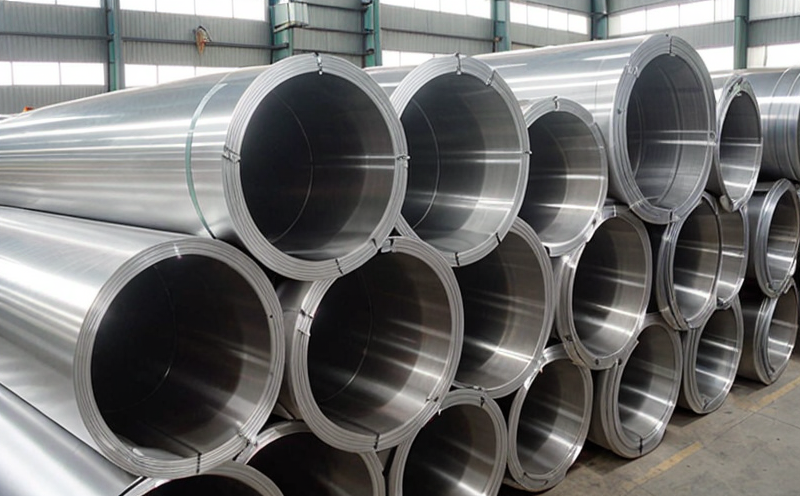IEC 60068-2-38 Temperature/Humidity Combined Testing
The IEC 60068-2-38 standard specifies temperature/humidity combined tests for the determination of the effects of cycling temperatures and humidity on electrical equipment, materials, and components. This testing is crucial for ensuring that marine and ship equipment made from aluminium can withstand harsh environmental conditions.
Aluminium used in marine applications is subjected to a variety of stressors including saltwater exposure, temperature fluctuations, and mechanical stresses. IEC 60068-2-38 provides a standardized method to assess the performance and reliability of such materials under these combined environmental factors. The test involves subjecting samples to controlled cycles of temperature and humidity that simulate real-world conditions experienced by marine equipment.
The testing protocol requires precise control over both temperature and relative humidity levels, ensuring accurate simulation of environments found in various maritime regions. This includes tropical climates with high humidity and cold arctic waters where low temperatures dominate. By subjecting samples to these conditions, manufacturers can ensure that their products meet the stringent requirements set forth by IEC standards.
The process begins with careful sample preparation which involves cutting or machining aluminium components into standardized sizes suitable for testing. Once prepared, the specimens are exposed to alternating cycles of temperature and humidity within specified ranges. These cycles simulate daily variations in marine environments where temperatures can vary dramatically between day and night.
During each cycle, precise measurements are taken using advanced instrumentation capable of measuring both temperature and relative humidity accurately down to millidegree precision. The data collected during these tests is then analyzed against predefined acceptance criteria outlined in IEC 60068-2-38 to determine whether the material meets required performance levels.
The results from this testing provide valuable insights into how well different types of aluminium will perform under specific environmental conditions. This information can be used by engineers and designers when selecting appropriate materials for new products or modifications to existing designs. It also helps quality managers ensure compliance with international standards while meeting customer expectations regarding durability and reliability.
By conducting IEC 60068-2-38 temperature/humidity combined tests, manufacturers can gain confidence that their marine equipment will function correctly even when exposed to extreme weather conditions at sea. This testing ensures that products are robust enough to withstand the challenges posed by saltwater corrosion and thermal shock without compromising on performance.
| Environmental Factor | Test Range |
|---|---|
| Temperature (Celsius) | -40°C to +85°C |
| Relative Humidity (%RH) | 10% to 98% RH |
Why It Matters
The reliability and longevity of marine equipment are paramount for the safety and efficiency of ships operating in various maritime conditions. Given that aluminium is commonly used in ship construction, ensuring its resilience against environmental stressors like temperature and humidity is essential. Compliance with IEC 60068-2-38 helps manufacturers verify that their products meet rigorous performance standards set by international authorities.
For quality managers overseeing production processes, knowing whether materials comply with these global benchmarks provides reassurance about product quality and customer satisfaction. Additionally, compliance fosters trust among buyers who prioritize reliability over cost savings. Engineers responsible for R&D benefit from detailed test results that guide future innovations aimed at improving material performance in challenging environments.
Compliance officers play a critical role in ensuring adherence to regulatory requirements across industries worldwide. By adhering to standards like IEC 60068-2-38, companies demonstrate their commitment to maintaining high standards of product integrity and safety. This not only enhances brand reputation but also reduces potential risks associated with non-compliance.
Procurement teams can leverage the outcomes of these tests when sourcing materials for new projects or upgrading existing fleets. Knowledge gained from IEC 60068-2-38 enables them to make informed decisions about which suppliers provide products that meet stringent quality benchmarks. Ultimately, this contributes towards reducing maintenance costs and enhancing overall operational efficiency.
Benefits
- Enhanced Reliability: Ensures that aluminium materials used in marine equipment can withstand harsh environmental conditions without degradation or failure.
- Increased Durability: Improves the lifespan of components by identifying potential weaknesses early on during development stages.
- Compliance Assurance: Meets international standards, thereby ensuring compliance with regulations governing maritime operations globally.
- Cost Efficiency: Reduces long-term expenses related to repairs and replacements due to improved material performance.
- Better Decision-Making: Provides valuable data for R&D teams to develop more robust designs tailored specifically for marine applications.
- Enhanced Reputation: Establishes credibility among clients who value reliability and safety in their equipment choices.
- Environmental Sustainability: By using tested materials, manufacturers contribute towards reducing waste generation associated with frequent replacements caused by substandard components.
The benefits of conducting IEC 60068-2-38 temperature/humidity combined testing extend beyond just meeting regulatory requirements; they also enhance the overall quality and safety of marine equipment. This ultimately leads to improved operational efficiency, reduced downtime, and increased customer satisfaction.
Industry Applications
The IEC 60068-2-38 temperature/humidity combined testing is applicable across various sectors within the maritime industry. Here are some key areas where this type of testing plays a vital role:
- Cargo Handling Equipment: Ensures that cranes, loaders, and other cargo-handling machinery can operate effectively despite exposure to saltwater and fluctuating temperatures.
- Navigation Systems: Guarantees the accuracy and reliability of GPS devices, compasses, and radar systems which are crucial for safe navigation at sea.
- Mechanical Components: Tests gears, bearings, and other moving parts to ensure they function correctly under extreme conditions encountered during ship operations.
- Air Conditioning Units: Verifies that cooling systems maintain optimal performance levels in both hot tropical climates as well as cold arctic regions.
The data obtained from these tests is invaluable for manufacturers and suppliers looking to improve the overall quality of their products. It helps them identify areas needing improvement, implement necessary changes, and ultimately produce more reliable equipment suited for marine environments.





